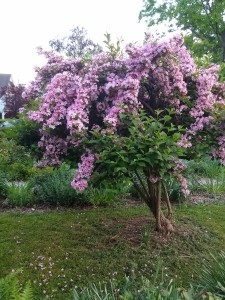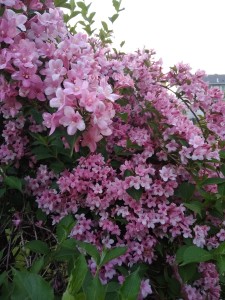 I love etymology, the study of word origins. That is partly why I am intrigued by weigela, a gorgeous flowering shrub that is having its moment of glory just now, in mid to late May. Weigela is part of the larger honeysuckle plant family, known botanically as Caprifoliaceae. If you are into astrology, you know that Capricorn is the sign of the goat. When you combine “capri” or “goat-like” with “folia”, which means leaves, you get a plant with goat-like leaves. No matter how many times I examine the weigela in my front yard, I can’t see anything goat-like about the leaves. Go figure.
I love etymology, the study of word origins. That is partly why I am intrigued by weigela, a gorgeous flowering shrub that is having its moment of glory just now, in mid to late May. Weigela is part of the larger honeysuckle plant family, known botanically as Caprifoliaceae. If you are into astrology, you know that Capricorn is the sign of the goat. When you combine “capri” or “goat-like” with “folia”, which means leaves, you get a plant with goat-like leaves. No matter how many times I examine the weigela in my front yard, I can’t see anything goat-like about the leaves. Go figure.
Fortunately I am fond of looking at my two weigelas, the more luxurious of which is growing in standard or tree form. At the moment the leaves are barely visible beneath cascades of pink, tubular blossoms. For reasons that I cannot fathom, but might owe something to the long, cool, wet spring, my weigelas are as floriferous this year as they have ever been. I am not complaining, especially since I did absolutely nothing to create the spectacular show.
Weigela—pronounced “wy-gee-lah”—is one of those rare plants that does not seem to have a romantic common name. This is strange, because its botanical name does not exactly trip off the tongue. Still, even without romantic name associations, it is a beautiful thing. Native to northeastern China, Korea and Japan, it is a deciduous shrub that does well in temperate regions with relatively cold winters. In its Asian home areas it has been grown in gardens for centuries. Weigela eventually attracted the attention of western plant hunters, like Scottish botanist Robert Fortune, who purchased specimens in Shanghai in the mid nineteenth century and brought them back to Western Europe. Queen Victoria reportedly saw one of those imported weigelas and was quite taken with it.
Here in the United States, we shared the Queen’s enthusiasm. According to plant historian Denise Adams, the shrub was introduced here in 1843, and listed in a catalog as early as 1851. Since weigela was easy to grow and showy in spring, it had become a garden standard, by the late nineteenth century.
Many modern weigelas are descendants of Weigela florida, the plant that Robert Fortune secured. Since Fortune first got his hands on it, plant breeders have gone to town. The species version can grow six to 12 feet tall, with a spread of 9 to 12 feet and rose-pink spring flowers. The medium green leaves are opposed on the stems, ovoid in shape and toothed around the edges. They are attractive, but nothing to write home about all by themselves.
Plant breeders, who can see possibilities where most of us just see excessive pruning chores, have spent more than a century crossing Weigela florida with other weigela species to create bushes that are more interesting, colorful, compact and hardy. As early as 1905, an Ohio catalog listed ‘Variegata’, a variety with cream-edged leaves. The catalog “sold” that variety with a highly idealized chromolithograph illustration that showed leaves bigger than the flowering branches. Even then merchandisers lured potential buyers with a highly idealized vision of plant perfection.  Fortunately those buyers also took to the real thing.
Fortunately those buyers also took to the real thing.
These days we have lots of weigela hybrids and varieties to choose from—so many in fact that woody plant guru Michael Dirr throws up his rhetorical hands and says, “One truly needs a score card to keep track of the many cultivars that have resulted from hybridization among the various species.”
‘My Monet’, a compact, variegated variety, is among the best selling weigelas. Growing about 18 inches tall and wide, it works well in small gardens or containers. The branches cover themselves with pink flowers and the variegated leaves add interest in the off season.
I have seen a lot of ‘Midnight Wine’ in my travels recently. It is about the same size as ‘My Monet’, but boasts near-black foliage. The flowers are dark pink and not quite as showy as those of other weigelas. The dark-leafed drama makes up for it.
Nothing looks fresher than white flowers in spring and you can get those with varieties like Czechmark ‘’Sunny Side Up’, featuring white blooms accented with yellow throats. At three to five feet tall, it is a little bigger than some of the compact varieties, but nowhere near as statuesque as the species.
If you like the look of traditional weigelas, but can’t take the size, try ‘Minuet’, which grows three feet tall and up to five feet wide. Developed in Canada, it is more cold tolerant that many other varieties. The blooms, like those of some other weigelas, are lightly fragrant.
All the weigelas flower most lavishly in mid-spring, but will sometimes throw off a sprinkling of fresh blooms later in the summer. This happens in my garden every year, but somehow it always surprises me anyway.
If you buy a weigela, put it in a sunny spot that has well-drained soil. Mulch it thoroughly and water during dry spells. The right time to prune is after the spring blooms fall. Don’t worry about harming the plant. It responds well to even hard pruning.
Most nurseries and garden centers stock weigelas, often produced by big plant wholesalers like Proven Winners and Monrovia. ForestFarm also has some good choices. Find them at 14643 Water Gap Rd, Williams,OR 97544; (541)846-7269; www.forestfarm.com. Free print catalog.
